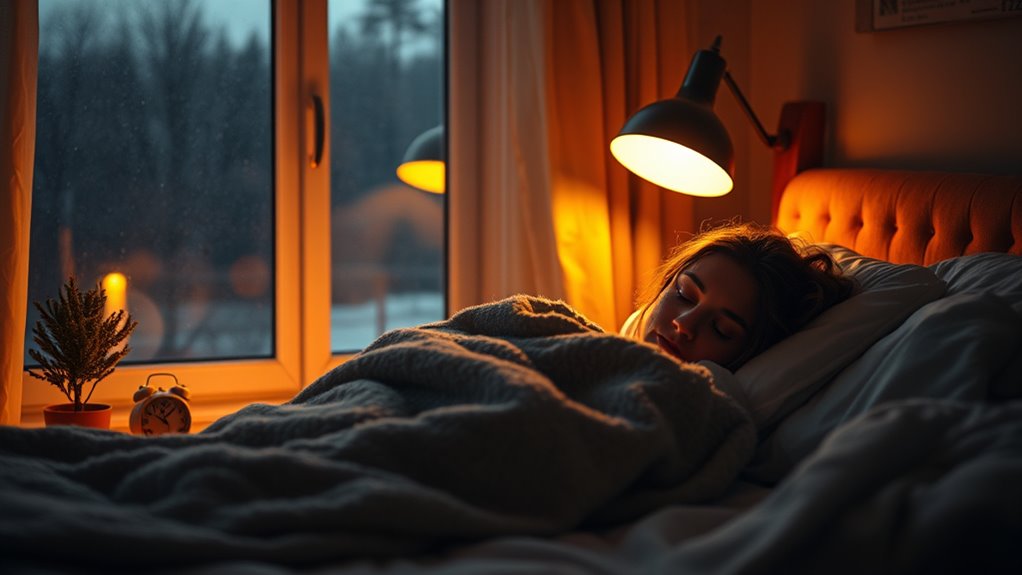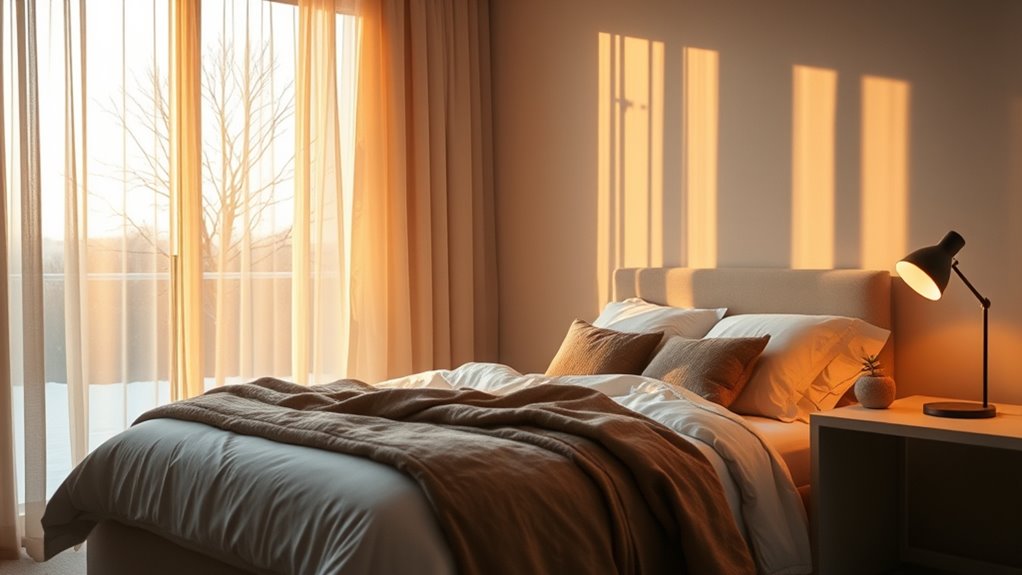If you’re dealing with seasonal affective disorder, I recommend maximizing natural light by spending time outside each day and using a light therapy box in the morning to boost your mood. Maintaining a consistent sleep schedule, creating a calming bedtime routine, and keeping your environment dark and quiet can help improve your sleep. These simple daily habits can make a real difference, and if you keep exploring, you’ll find even more ways to manage your mood during darker months.
Key Takeaways
- Regular morning light therapy with a specialized light box helps regulate circadian rhythms and improve mood during darker months.
- Maintaining a consistent sleep schedule and creating a calming bedtime routine enhances overall sleep quality and mood stability.
- Increasing daytime exposure to natural sunlight through outdoor activities supports internal clock regulation and boosts energy.
- Using blackout curtains and white noise machines in the bedroom promotes restful sleep and reduces environmental disruptions.
- Combining light therapy with good sleep hygiene and routine adjustments offers an effective, personalized approach to managing SAD.

Many people notice their mood dips and energy wanes as the seasons change, but for some, these feelings are more intense and persistent. If you find yourself feeling consistently down, sluggish, or unmotivated during certain times of the year, you might be experiencing seasonal affective disorder (SAD). It’s a real condition that goes beyond typical winter blues, often linked to reduced sunlight and disrupted routines. One of the most effective ways I’ve found to combat this is through light therapy. This involves sitting in front of a special light box that mimics natural sunlight, helping to regulate your circadian rhythm and boost your mood. I try to do light therapy first thing in the morning, as it helps set a positive tone for the day. It’s simple, non-invasive, and surprisingly effective. I also pay close attention to my sleep hygiene, knowing that good sleep habits are vital for overall mental health. That means sticking to a consistent sleep schedule, avoiding screens before bed, and creating a calming bedtime routine. When I maintain these habits, I notice a significant improvement in my energy levels and mood. Poor sleep can exacerbate feelings of depression, so I make sure my bedroom is cool, dark, and quiet. Sometimes, I even use blackout curtains and a white noise machine to remove distractions and create an environment conducive to restful sleep. I’ve learned that establishing a routine helps my body anticipate sleep and wake times, making it easier to fall asleep and wake up refreshed, even during the darker months. Incorporating light therapy devices into my daily routine has also made a noticeable difference. Combining light therapy with proper sleep hygiene has been a game-changer for me. It’s not just about one or the other; it’s about creating a daily rhythm that supports your mental health. I also try to get outside during daylight hours as much as possible, even if it’s just a quick walk around the block. Natural light is the best kind of light for regulating your internal clock. When I make these small adjustments—using light therapy, improving sleep hygiene, and maximizing daylight exposure—I find that my mood stabilizes, and I feel more energized and motivated. It’s important to remember that managing SAD is a continuous process, and what works may vary from person to person. But starting with these foundational habits can make a significant difference in steering through the darker months with more resilience and hope.
Frequently Asked Questions
Can Dietary Changes Help Alleviate Seasonal Affective Disorder Symptoms?
Yes, dietary changes can help alleviate SAD symptoms. I’ve found that incorporating nutritional supplements like omega-3s and vitamin D, along with improved dietary patterns rich in fruits, vegetables, and whole grains, makes a difference. These habits support my mood and energy levels during darker months. While they aren’t a cure, adjusting your diet can be a helpful part of managing SAD alongside other treatments.
Are There Natural Remedies That Effectively Treat SAD?
Yes, I’ve found that natural remedies like herbal supplements and aromatherapy techniques can help treat SAD symptoms. Herbal supplements such as St. John’s Wort may boost mood, while lavender or chamomile essential oils used in aromatherapy promote relaxation and alleviate stress. I recommend trying these options alongside other healthy habits. Just remember to consult a healthcare professional before starting any new supplement or therapy to guarantee safety.
How Does Physical Activity Influence SAD Management?
Physical activity profoundly impacts SAD management by boosting mood and battling bleakness. I find that outdoor activities like walking or cycling not only motivate me to exercise but also provide sunlight, which lifts my spirits. Exercise releases endorphins, making me feel more energized and optimistic. So, get moving outside—it’s a simple, powerful way to fight sadness, stay motivated, and embrace a brighter, healthier mindset every day.
What Are the Long-Term Effects of Untreated SAD?
If left untreated, SAD can lead to chronic depression and serious mental health consequences. I’ve seen how long-term neglect worsens mood, drains energy, and strains relationships. Over time, it can cause feelings of hopelessness and even increase risk for other mental health issues. Addressing it early with proper light therapy, sleep routines, and habits is vital to prevent these long-term effects and maintain well-being.
Can SAD Recur Multiple Times Throughout a Person’s Life?
Yes, SAD can reappear like seasons changing, especially if you have a genetic predisposition or face environmental triggers again. I’ve seen many people experience its return year after year, like a stubborn guest. Staying aware of triggers and managing habits helps prevent recurrence. It’s a cycle, but with proper care, you can keep SAD at bay and enjoy brighter days ahead.
Conclusion
If you think SAD is just a little blah, think again. It’s like a relentless storm draining your energy, dimming your joy, and turning every day into a battle. But remember, tiny changes in light, sleep, and habits can be your mighty shield against this darkness. Don’t let SAD steal your life—rise up, take control, and ignite your inner fire. You have the power to banish the gloom and reclaim your happiness!









